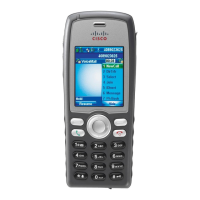Default Export
If needing to deploy the Cisco Unified Wireless IP Phone 7925G, 7925G-EX, and 7926G with identical WLAN settings, then
select the Default Export method.
After selecting Default Export the utility will create a TFTP downloadable configuration file based on the common data
entered, which is exported to the application install path (C:\Program Files\Cisco Systems\7921BD).
A confirmation window will be displayed when the default TFTP downloadable configuration file has been exported
successfully.
The default file will be in the format of WLANDefault.xml, which the phone does a TFTP get for when it powers on or during
re-provisioning.
Pushing Configuration Files to the Cisco 792xG
The Bulk Deployment Utility can be utilized for initial deployment or after the Cisco Unified Wireless IP Phone 7925G,
7925G-EX, or 7926G has been deployed.
Install the Bulk Deployment Utility on a computer running Microsoft Windows.
The Bulk Deployment Utility does not have TFTP server capabilities, so an external TFTP server will be required, where the
phone configuration files will need to be copied to and enabled for TFTP download.
For initial deployment, the recommendation is to set up a staging environment where the Cisco Unified Wireless IP Phone
7925G, 7925G-EX, and 7926G can connect to a wireless LAN using the default phone credentials, obtain an IP address via
DHCP and TFTP download the phone configuration file. This setup will enable the phone to auto-download the configuration
files by simply powering the Cisco Unified Wireless IP Phone 7925G, 7925G-EX, and 7926G on. The staging environment
setup needs to consist of an access point with the SSID cisco configured and DHCP enabled either on the access point itself or
another device in the local network, where DHCP option 150 is configured to point to the TFTP server’s IP address that is
hosting the phone configuration files.
For post-deployment where Cisco Unified Wireless IP Phone 7925G, 7925G-EX, and 7926G are already being utilized on the
production wireless LAN, copy the phone configuration files to the TFTP server that the Cisco Unified Wireless IP Phone
7925G, 7925G-EX, and 7926G are pointed to, then reset the phones to reconnect to the production wireless LAN and TFTP
download the phone configuration file. The TFTP service may need to be restarted prior to resetting the phones depending on
which type of TFTP server is utilized.
After the phone received the configuration file, the Cisco Unified Wireless IP Phone 7925G, 7925G-EX, or 7926G will then re-
provision with the new settings and attempt to join the intended wireless LAN.
For additional security, the recommendation is to remove any phone configuration files from the TFTP server when not needed.
The Bulk Deployment Utility is available for download at the following URL.
http://software.cisco.com/download/navigator.html?mdfid=278875240
Wavelink Avalanche
The Wavelink Avalanche server IP address can be set either via DHCP option 149 or statically.
To provide the server IP address automatically, configure option 149 on the DHCP server.
ip dhcp pool 10.10.11.0
network 10.10.11.0 255.255.255.0
default-router 10.10.11.1

